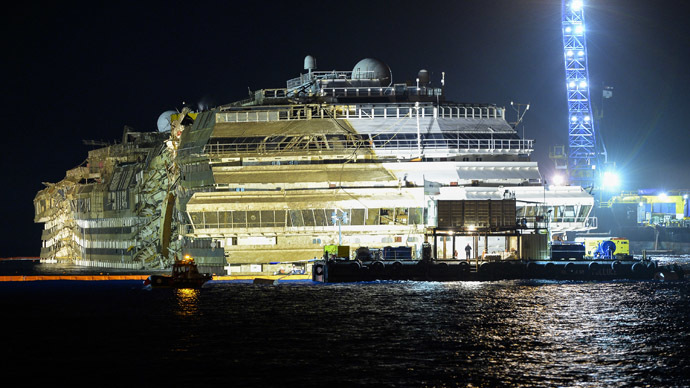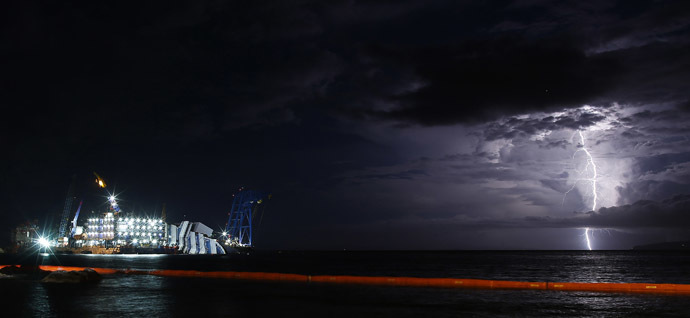Wrecked Costa Concordia cruise ship set upright (PHOTOS, VIDEO)

A multinational crew has completed the righting of the wrecked Italian cruise ship Costa Concordia early on Tuesday following a 19-hour long operation that cost over $800 million.
The 950-foot-long, 114,000-ton ship -- lying on its side off a rock shelf since it smashed into the Giglio mountainside in January 2012 -- was pulled upright by a system of 56 pulleys attached to underwater platforms.
"The ship has been settled on to its platforms," Franco
Gabrielli, the head of Italy's Civil Protection Authority
said.
Towers with hydraulic mechanisms controlling 205-kg (450
lb) cables under the ship and attached to its side slowly rotated
the vessel, placing it on six platforms drilled into the granite
rock bed.

As the ship rotated, cable pressure was released, leaving giant
tanks on the ship's exposed side to fill with water, helping the
ship continue tipping upright by force of gravity.
It took 6,000 tons of pressure for the pulleys to dislodge the
ship’s flank from rock, which pierced 18 feet into the
brown-stained white hull.

"The ship is reacting very well because it's rotating in a
uniform fashion, which is what we expected but it's a pleasure to
see it confirmed," Franco Porcellacchia, leader of Costa
Cruise's technical team, told Reuters early in the process.
A team of 500 salvage engineers have worked on the ship and rock
bed for the past year, stabilizing the wrecked area in preparaton
for Monday’s lift by a process known as parbuckling.
"We have done parbuckling before but never on a location like
this," Nick Sloane, the engineer coordinating the recovery
effort for contractor Titan Salvage, told Reuters.
"She is on the side of a mountain on the seabed, balanced on
two reefs and she is a really large ship - she's three football
fields long, a hundred thousand tonnes plus ... So it's never
been done on this scale," he said.

The Concordia capsized on January 13, 2012, as the ship’s Captain
Francesco Schettino hit the rock bed attempting a "sail
past" close to the island.
The vessel was carrying more than 4,000 people
when it crashed, killing 32. Two bodies have yet to be recovered
from the wreck.
Schettino is currently standing trial on charges of manslaughter
and abandoning his ship.
Engineers told the Los Angeles Times the ship needed to be at 65
degrees to sit upright on the underwater platforms.
The Costa Concordia is the largest ship ever to be hoisted
upright after capsizing.
Over 1mn gallons of water was removed from the food storage area
and laundry areas of the ship ahead of the salvage operation.
Oil booms surround the Concordia to intercept waste water and oil
trapped in the ship, but no observable environmental damage has
been reported thus far.

















